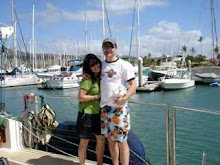We have had a wonderful experience here, and wouldn't trade it for anything. Yap is a beautiful, magical place. A place where tradition and family and communal ties are still strong. A place that hasn't given in to the all of the temptations of Western material culture. We have learned so much here about living in cultures different from our own, and even more about ourselves. We will leave something of ourselves in the islands, and we hope, in exchange, the islands will send a piece of their spirit with us. It's been a blast. Thanks for reading.


































